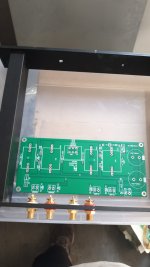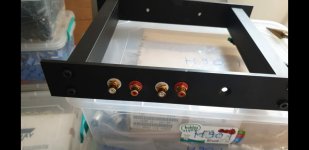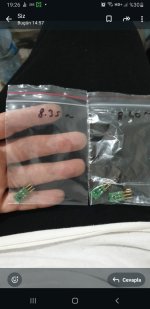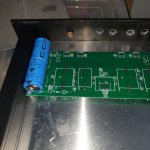Yes but a good quality logarithmic version may be more suitable. Certainly if you are used to standard logarithmic volume control as in about every other device. FWIW my DCB1 has a logarithmic 20 kOhm one. Linear ones are a pest for normal experience volume control.
When using stepped volume control one will find out very quickly that 24 steps are really far from enough.
When using stepped volume control one will find out very quickly that 24 steps are really far from enough.
Last edited:
well, if using linear stepped, 24 is certainly not enough
if log, functionally it is enough, except if used in some professional purposes or if amateur user is spoiled
if log, functionally it is enough, except if used in some professional purposes or if amateur user is spoiled

The trouble is that it is practically either a tad too loud or a tad too soft. Also the range has quite a few steps that are never used. IMHO category “self inflicted nuisances” when compared to the experience of operating a potentiometer. Starts to be equivalent at 40 steps (or with trickery/switches).
All with regards to user experience/friendliness. If it is about perceived quality one for sure can get rid of ones money in either direction 🙂
All with regards to user experience/friendliness. If it is about perceived quality one for sure can get rid of ones money in either direction 🙂
Last edited:
I find adding a low volume/high volume range switch I.e. “trickery/switches” a good solution. I use my “low range 90% of the time. It also keeps the visiting youngster from frying your speakers..
Last edited:
Hello everyone,
I remember reading that in a pair of 2SK170BL (or similar JFETs like 2SK209GR), the one with higher Idss is preferred for a certain position, but I can't recall exactly — is it better to use the higher Idss JFET on the top or bottom?
I recently matched a bunch of 2SK209GRs (I have a few thousand of them 😅) and measured Idss using a 9V adapter and 100R in series — though it was an older one and gave around 8.5V. I hope this slight difference in voltage won't cause a problem for Idss matching purposes.
I'm also considering putting a 47Ω resistor on the output — perhaps to isolate or stabilize the output. Any thoughts or experiences on this would be appreciated.
Thanks in advance!
I remember reading that in a pair of 2SK170BL (or similar JFETs like 2SK209GR), the one with higher Idss is preferred for a certain position, but I can't recall exactly — is it better to use the higher Idss JFET on the top or bottom?
I recently matched a bunch of 2SK209GRs (I have a few thousand of them 😅) and measured Idss using a 9V adapter and 100R in series — though it was an older one and gave around 8.5V. I hope this slight difference in voltage won't cause a problem for Idss matching purposes.
I'm also considering putting a 47Ω resistor on the output — perhaps to isolate or stabilize the output. Any thoughts or experiences on this would be appreciated.
Thanks in advance!
Attachments
Thank you for your answer. So signal driving jfet has higher IDSS. I was confused which one it was.How many per cent is good ? Maybe 10% or higher?
Allways smart to have a fuse. Just in case if "something happening in the amplifier , like a short curcuit,,,Hi !
Do I understand you correctly if I say that the power supply needs a fuse, if I build it from scratch, but not the B1 buffer circuit?
Having difficulties finding a switcher / wall wart / power adapter, on net, with a autorestart / short circuit protection...
Thanks for clearifyring my thoughts around coupling caps / DC blocking.
Thank you!
Papa has something he always says about this. It's more original than "Safety first", but I can't remember quite what it is.... Still, wisdom.
I find adding a low volume/high volume range switch I.e. “trickery/switches” a good solution. I use my “low range 90% of the time. It also keeps the visiting youngster from frying your speakers..
Hadn't thought of this before. It might be useful with a stepped attenuator, utilizing more steps in a given range of volume. Got to think that one over. It sort of reminds me of the Glass-Ware Audio volume control that uses a fine and coarse selection between two switches. This gives quite a few more steps depending on application.
From original article:
"...On the bottom end, the low frequency roll-off is about 1.5 Hz into a 10 Kohm load and about 0.3
Hz into 47 Kohm. ..."
"...On the bottom end, the low frequency roll-off is about 1.5 Hz into a 10 Kohm load and about 0.3
Hz into 47 Kohm. ..."
I was planning to cross my full-range speakers at around 150 Hz, so I was wondering about the output capacitor values. I’m considering replacing the typical 10µF output capacitor with a 100nF one. Would this cause any harm to 8-ohm full-range speakers?
Alternatively, I’m also thinking of using 100nF at the input and 1µF at the output.
My goal is to naturally roll off the low end since I’ll be high-passing the full-range drivers around 150 Hz. Would using a smaller output cap help in this regard, or would it negatively affect sound quality or speaker safety?
Any insight or experiences would be much appreciated. 😊
Alternatively, I’m also thinking of using 100nF at the input and 1µF at the output.
My goal is to naturally roll off the low end since I’ll be high-passing the full-range drivers around 150 Hz. Would using a smaller output cap help in this regard, or would it negatively affect sound quality or speaker safety?
Any insight or experiences would be much appreciated. 😊
Your alternate of dividing each by 10 should be okay and get you f(lo) of 15Hz into 1 kohm, one tenth of your xover f. That could save you a few bucks (or whatever your currency) and maybe allow a better cap. You could scale further with a 47k load, but I wouldn't want to go higher than 15Hz. I don't see a safety concern.
So with 6,8uF and a Pass F5m (47K) i am on safe side and below 1Hz.From original article:
"...On the bottom end, the low frequency roll-off is about 1.5 Hz into a 10 Kohm load and about 0.3
Hz into 47 Kohm. ..."
Hi.I'm planning to use a 22,000 µF 25V capacitors in a B1 buffer. It's the same physical size as a 15,000 µF ones and I'll mount it horizontally. Will this cause the SMPS to draw significantly more current at startup, and could that be harmful to the SMPS?
Attachments
- Home
- Amplifiers
- Pass Labs
- B1 Buffer Preamp



